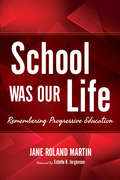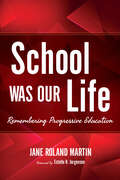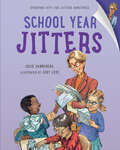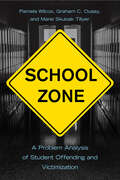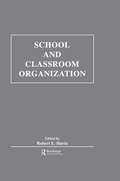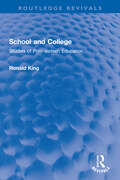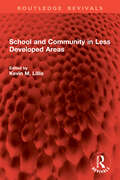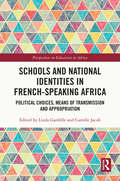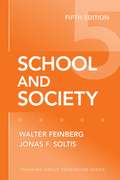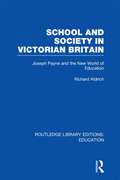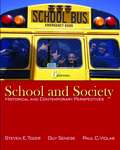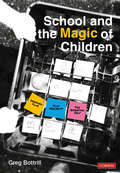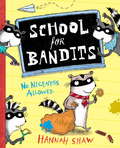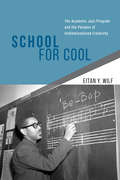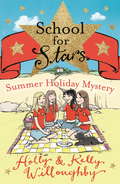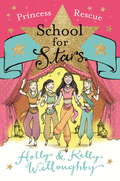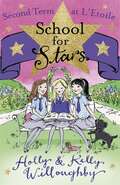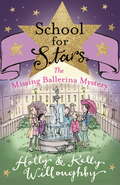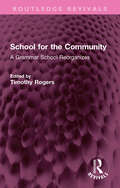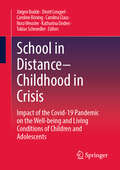- Table View
- List View
School Was Our Life: Remembering Progressive Education (Counterpoints: Music and Education)
by Estelle R. Jorgensen Jane Roland MartinThe late 1930s and early 1940s were the peak of progressive education in the United States, and Elisabeth Irwin's Little Red School House in New York City was iconic in that movement. For the first time, stories and recollections from students who attended Little Red during this era have been collected by author Jane Roland Martin. Now in their late eighties, these classmates can still sing the songs they learned in elementary school and credit the progressive education they loved with shaping their outlooks and life trajectories. Martin frames these stories from the former students "tell it like it was" point of view with philosophical commentary, bringing to light the underpinnings of the kind of progressive education employed at Little Red and commenting critically on the endeavor. In a time when the role of the arts in education and public schooling itself are under attack in the United States, Martin makes a case for a different style of education designed for the defense of democracy and expresses hope that an education like hers can become an opportunity for all.
School Was Our Life: Remembering Progressive Education (Counterpoints: Music and Education)
by Jane Roland MartinPersonal accounts of the early days of New York City’s Little Red School House, analysis of its success, and a look at the future of education.The late 1930s and early 1940s were the peak of progressive education in the United States, and Elisabeth Irwin’s Little Red School House in New York City was iconic in that movement. For the first time, stories and recollections from students who attended Little Red during this era have been collected by author Jane Roland Martin. Now in their late eighties, these classmates can still sing the songs they learned in elementary school and credit the progressive education they loved with shaping their outlooks and life trajectories. Martin frames these stories from the former students “tell it like it was” point of view with philosophical commentary, bringing to light the underpinnings of the kind of progressive education employed at Little Red and commenting critically on the endeavor. In a time when the role of the arts in education and public schooling itself are under attack in the United States, Martin makes a case for a different style of education designed for the defense of democracy and expresses hope that an education like hers can become an opportunity for all.“This sparkling, intimate, and delightfully written memoir demonstrates conclusively how and why elementary education should be designed to fit the natural growth of the human mind.” —E.O. Wilson author of The Social Conquest of Earth“Drawing on her own experiences 75 years ago and those of her classmates, researchers and many others, [Jane Roland Martin] has made it clear why we, even though she and the rest of us privileged to have gone through Little Red can’t write cursive and never had to memorize facts and figures, are “The Lucky Ones.” She draws on memories of everything from class trips, to writing poetry, to group singing to explain why much of the conventional literature about progressive education has missed the story. If it’s too late for you to apply (or send your children and/or grandchildren) to Little Red, read School Was Our Life: Remembering Progressive Education. It’s the next best thing.” —Victor S. Navasky, publisher emeritus of The Nation
School Year Jitters (The Jitters Series)
by Julie DannebergIn this epistolary follow-up to the best-selling First Day Jitters and Last Day Blues, Mrs. Hartwell receives letters over the course of one school year from just about everyone.As every first-year teacher knows, a classroom full of second graders can be alarmingly unpredictable.The letters the children write to Mrs. Hartwell are sympathetic ("I figured you might be a little scared, just like me"); informative ("…most kids don't eat cauliflower"); encouraging ("Yesterday was THE BEST!"); and apologetic ("I'm sorry about throwing up all over your shoes"). Even a local firefighter writes to Sarah Jane.Fun, funny, and heart-warming, Danneberg&’s The Jitters series is sure to delight both teachers and children as they follow Mrs. Hartwell and her class through the year. With School Year Jitters, classes will be inspired to write letters to their own teachers about their favorite, or wildest, days of the year.
School Zone: A Problem Analysis of Student Offending and Victimization
by Pamela Wilcox Graham C. Ousey Marie Skubak TillyerSchools should be safe—but they are not always safe for everybody. Authors Pamela Wilcox, Graham Ousey, and Marie Skubak Tillyer studied crime among students located across diverse middle- and high-school settings to investigate why some students engage in delinquency—but others do not—and why some students are more prone to victimization. School Zone focuses on the three key interactional elements—context, victims, and offenders—to understand and explain the impact of common crimes such as theft, weapon carrying, drug possession and the verbal, physical, and sexual harassment of classmates. The authors also consider how individual students and schools respond to crime and threats. They analyze the variables that schools can control in planning and practice that explain why some schools have higher crime rates. School Zone uses empirical studies to provide a comprehensive understanding of the patterns and causes of variation in individual- and aggregate-level school-based offending and victimization experiences while also addressing the adequacy of wide-ranging criminological explanations and crime prevention policies. In their conclusion, the authors assess the extent to which currently popular strategies of school crime prevention align with what they have discovered through their problem-analysis framework and scientific understandings of student offending and victimization.
School and Classroom Organization
by Robert E. SlavinBecause the organization of the classroom and the school provide the framework for teaching and learning, this important volume reviews research that focuses on specific issues including: achievement effects of alternative school and classroom organizational practices, ability grouping, departmentalization, special and remedial programs, evaluation processes, and class size. The studies utilize realistic evaluations rather than laboratory or experimental data, and do not prescribe particular practices.
School and College: Studies of Post-sixteen Education (Routledge Revivals)
by Ronald KingFirst published in 1976, School and College is a comparison of the variety of educational institutions – sixth forms, sixth form units, sixth form centres, sixth form colleges, school-college consortia, colleges of further education and tertiary colleges – attended by young people between sixteen and nineteen years of age. Each of these was supported by different educational interest groups, who made suppositions about their respective advantages and disadvantages. The findings reveal that what was supposed to happen sometimes did not happen. Dr. King explores the origin of the ideas behind each form of organisation, and examines the groups that propagated them. These ideas concerned not only the form of organisation but also the nature of education itself. He compares the policies with their practice, and concludes that changes might be required before the expectations of both students and educators can be fulfilled. This book will be of interest to teachers and students of education and pedagogy.
School and Community Interactions
by Andreas Brunold Bernhard OhlmeierWithin the European and Asian context scientists from nine different countries are concerned with political and social interactional structures between schools as public institutions and the local political actors which influence the school environment. The contributions give answers to questions regarding the cooperation between school administrations and community, to civic education for sustainable development at the interface between school and community, to teachers as moderators for political and democratic educational processes and to models for successful cooperation between schools and local political actors.
School and Community in Less Developed Areas (Routledge Revivals)
by Kevin M. LillisThere has long been a debate about the role of schools and relevant education in community development in less developed areas. Efforts are continually being made to relate the work of schools more closely to the life of the local community. First published in 1985, School and Community in Less Developed Areas discusses this important subject.This volume considers relevant theory and reviews specific examples to highlight the difficulties of translating intentions into practice. It examines the problem as it relates to education at different levels and looks at the problem in relation to less developed areas, both Third World countries and the more backward parts of developed countries, from right around the world. The book will be a beneficial read for students and researchers of education.
School and National Identities in French-speaking Africa: Political Choices, Means of Transmission and Appropriation (Perspectives on Education in Africa)
by Linda Gardelle Camille JacobSchools and National Identities in French-speaking Africa showcases cutting-edge research to provide a renewed understanding of the role of schools in producing and reproducing national identities. Using individual case studies and comparative frameworks, it presents diverse empirical and theoretical insights from and about a range of African countries. The volume demonstrates in particular the usefulness of the curriculum as a lens through which to analyse the production and negotiation of national identities in different settings. Chapters discuss the tensions between decolonisation as a moment in time and decolonisation as a lengthy and messy process, the interplay between the local, national and international priorities of different actors, and the nuanced role of historiography and language in nation-building. At its heart is the need to critically investigate the concept of "the nation" as a political project, how discourses and feelings of belonging are constructed at school, and what it means for schools to be simultaneously places of learning, tools of socialisation and political battlegrounds. By presenting new research on textbooks, practitioners and policy in ten different African countries, this volume provides insights into the diversity of issues and dynamics surrounding the question of schools and national identities. It will be of particular interest to scholars, researchers and postgraduate students of comparative and international education, sociology, history, sociolinguistics and African studies.
School and Society
by Jonas F. Soltis Walter Feinberg Pamela WolfbergThis widely used text has been expanded to include the most important issues in contemporary schooling, including new end-of-chapter sections for Further Reading and new references added to the useful Additional Resources section. School and Society, Fifth Edition uses realistic case studies, dialogues, and open-ended questions designed to stimulate thinking about problems related to school and society, including curriculum reform, social justice, and competing forms of research. Written in a style that speaks directly to today's educator, this book tackles such crucial questions as: Do schools socialize students to become productive workers? * Does schooling reproduce social class and pass on ethnic and gender biases? * Can a teacher avoid passing on dominant social and cultural values? * What besides subjects do students really learn in schools? School and Society is one of the five books in the highly regarded Teachers College Press Thinking About Education Series, now in its Fifth Edition. All of the books in this series are designed to help pre- and in-service teachers bridge the gap between theory and practice.
School and Society in Victorian Britain: Joseph Payne and the New World of Education (Routledge Library Editions: Education #Vol. 1)
by Richard AldrichDrawing on hitherto-unused sources this book represents a shift in the historiography of British education. At the centre of the investigation is Joseph Payne. He was one of the group of pioneers who founded the College of Preceptors in 1846 and in 1873 he was appointed to the first professorship of education in Britain, established by the College of Preceptors. By that date Payne had acquired a considerable reputation. He was a classroom practitioner of rare skill, the founder of two of the most successful Victorian private schools, the author of best-selling text-books, a scholar of note despite his lack of formal education, and a leading member of the College of Preceptors and such bodies as the Scholastic Registration Association, the Girls’ Public Day School Trust, the Women’s Education Union and the Social Science Association.
School and Society: Historical and Contemporary Perspectives (6th Edition)
by Steven E. Tozer Guy Senese Paul C. ViolasThrough the use of a consistent analytic framework, this text shows how and why certain school-society issues first arose in this country and how they have changed over time.
School and the Magic of Children (Corwin Ltd)
by Greg BottrillIn this book, I share with you an alternative to the &‘school&’ of today. A way of creating the conditions for you to go on an adventure with children. Education should not be a predetermined journey with map already drawn, with no ability to leave the path or pause. It should be a co-adventure. This co-adventure can only take place when we take the first step into the unknown. This can feel daunting and can open us up to questions and uncertainty. However, once we do take that first step, an adventure lies ahead like no other – an adventure so magical that it can and will change everything. And the reason that this adventure is so special is that it will take you into the very soul of children and of yourself. In these pages, I offer you an invitation. It comes from my head and heart to speak to yours. It is not didactic. It is a way to create the conditions for the magic of children to thrive. - Greg
School and the Magic of Children (Corwin Ltd)
by Greg BottrillIn this book, I share with you an alternative to the &‘school&’ of today. A way of creating the conditions for you to go on an adventure with children. Education should not be a predetermined journey with map already drawn, with no ability to leave the path or pause. It should be a co-adventure. This co-adventure can only take place when we take the first step into the unknown. This can feel daunting and can open us up to questions and uncertainty. However, once we do take that first step, an adventure lies ahead like no other – an adventure so magical that it can and will change everything. And the reason that this adventure is so special is that it will take you into the very soul of children and of yourself. In these pages, I offer you an invitation. It comes from my head and heart to speak to yours. It is not didactic. It is a way to create the conditions for the magic of children to thrive. - Greg
School for Bandits
by Hannah ShawRalph Raccoon looks perfectly normal. But he doesn't act normal at all. He's disturbingly well behaved, clean and tidy, shockingly polite, and he even brushes his teeth! Mr. and Mrs. Raccoon are worried--how will Ralph ever become a great raccoon bandit like Grandpa Cutlass or Uncle Whiskers? It's time Ralph learned some bad manners . . . at Bandit School.Ralph has no chance of winning the "Best Bandit in School" competition--he's not very bandit-like at all. But sometimes good manners can be useful, and Ralph just might surprise everyone--including himself.From the Hardcover edition.
School for Cool: The Academic Jazz Program and the Paradox of Institutionalized Creativity
by Eitan Y. WilfJazz was born on the streets, grew up in the clubs, and will die—so some fear—at the university. Facing dwindling commercial demand and the gradual disappearance of venues, many aspiring jazz musicians today learn their craft, and find their careers, in one of the many academic programs that now offer jazz degrees. School for Cool is their story. Going inside the halls of two of the most prestigious jazz schools around—at Berklee College of Music in Boston and the New School for Jazz and Contemporary Music in New York—Eitan Y. Wilf tackles a formidable question at the heart of jazz today: can creativity survive institutionalization? Few art forms epitomize the anti-institutional image more than jazz, but it’s precisely at the academy where jazz is now flourishing. This shift has introduced numerous challenges and contradictions to the music’s practitioners. Solos are transcribed, technique is standardized, and the whole endeavor is plastered with the label “high art”—a far cry from its freewheeling days. Wilf shows how students, educators, and administrators have attempted to meet these challenges with an inventive spirit and a robust drive to preserve—and foster—what they consider to be jazz’s central attributes: its charisma and unexpectedness. He also highlights the unintended consequences of their efforts to do so. Ultimately, he argues, the gap between creative practice and institutionalized schooling, although real, is often the product of our efforts to close it.
School for Stars 4: Summer Holiday Mystery (School For Stars Ser. #4)
by Kelly Willoughby Holly WilloughbyJoin Molly, Maria, Pippa and Sally in the fourth book in the hugely popular SCHOOL FOR STARS SERIES, written by celebrity sisters Holly and Kelly Willoughby. Molly, Maria, Pippa and Sally are back and on a summer holiday, staying at the Fitzfoster's country house. But even when they are not spending their time at the glamorous School for Stars, trouble, mystery and adventure still follow the girls wherever they go! A picnic on the beach leads to a discovery of secret tunnels, smuggling antics and maybe even a ghostly sighting or two...This book is GLEE for 9+ and is perfect for fans of BALLET SHOES and MALLORY TOWERS.
School for Stars 4: Summer Holiday Mystery (School For Stars Ser.)
by Holly Willoughby and Kelly WilloughbyThe fourth story, and summer holiday special, in a glamorous and appealing new series about dance, drama and friendship by popular TV presenter and personality Holly Willoughby, writing with her sister Kelly.
School for Stars 7: The Princess Rescue
by Kelly Willoughby Holly WilloughbyTV presenter Holly Willoughby's seventh adventure written with her sister Kelly. Join schoolgirl detectives Molly, Maria, Pippa and Sally for more mystery and glamour, set in a contemporary school for the Performing Arts with the classic charm of BALLET SHOES and MALORY TOWERS.When an Indian princess arrives in school she wants to stop being royal and start doing normal things - pillow fights, midnight feasts and cooking are her idea of fun. The end of term extravaganza is a bake-off competition and Bollywood style play, so Princess Ameera and the girls are in their element. But someone is trying to get the Princess into serious trouble. Molly, Maria, Pippa and Sally jump at the chance of an adventure that will solve a royal mystery and rescue the princess.
School for Stars: Book 2
by Kelly Willoughby Holly WilloughbyThe second novel from the bestselling SCHOOL FOR STARS series written by celebrity sisters Holly and Kelly Willoughby. Catch up with Molly, Maria and Pippa as they return for their second term at the all-singing, all-dancing L'Etoile school.Christmas break is over and the three friends are reunited as they begin their second term at L'Etoile, the exclusive School for Stars. Little do they know what fun and surprises lay in store for them. A midnight mystery, a precious lost rose, centenary celebrations, a playful puppy with a twinkle in its eyes, and a royal visit are just some of the things that make them friends for ever.This book is GLEE for 9+ and is perfect for fans of BALLET SHOES and MALLORY TOWERS.
School for Stars: Book 5
by Kelly Willoughby Holly WilloughbyCatch up with Molly, Maria, Pippa and Sally for more glamour and mystery in their second year at L'Etoile, in this fifth SCHOOL FOR STARS story by popular TV presenter Holly Willoughby and her sister Kelly.Molly, Maria, Pippa and Sally are back for a new year at L'Etoile and they can't wait to get their skates on at the school's new Glacier Palace ice-rink! But after the arrival of a new set of twins at L'Etoile, jealously threatens to pull the girls apart! With new faces, new friends and a very ghostly surprise, this term promises more fun, more excitement and more mystery than ever before.This book is GLEE for 9+ and is perfect for fans of BALLET SHOES and MALLORY TOWERS.
School for Stars: Book 6
by Kelly Willoughby Holly WilloughbyJump back in with your favourite BFFs in the sixth story in the hugely popular SCHOOL FOR STARS series written by THIS MORNING TV presenter Holly Willoughby and her sister Kelly. After a busy term at L'Etoile, it's time for a London holiday. But adventure follows the friends wherever they go, and it's not long before they find themselves exploring hidden tunnels and buried secrets surrounding a missing ballerina. Here's a mystery to really keep them on their toes!This book is GLEE for 9+ and is perfect for fans of BALLET SHOES and MALLORY TOWERS.
School for the Community: A Grammar School Reorganizes (Routledge Revivals)
by Timothy RogersOriginally published in 1971, this is a first-hand account of how an old-established County Grammar School was transformed into a completely new Upper School and Community College in the Leicestershire system. From their experience the Headmaster and staff have compiled the sort of book which they would have found most helpful, giving a working account of their aims and objectives, and the problems they encountered in this reorganization. They discuss the failures and successes which they met in areas such as curriculum planning, the school council, the sixth form, the uniform debate, the less able children, and the treatment of specialized subjects. They also look at the special aspects of the institution, including the Design Centre and the Community College. Stewart Mason, Director of Education for Leicestershire, contributes a chapter on the Leicestershire Plan, in the establishment of which he played a central part. Now Bosworth Academy this is a fascinating look at the history of how the school came to be.
School in Distance – Childhood in Crisis: Impact of the Covid-19 Pandemic on the Well-being and Living Conditions of Children and Adolescents
by Jürgen Budde Nora Weuster Tobias Schroedler Drorit Lengyel Caroline Böning Carolina Claus Katharina DodenThe volume reevaluates the common notions of a good childhood, which are influenced in various ways by the Covid-19 pandemic. The perspectives of children and adolescents on the pandemic have rarely been the subject of discussion. Thematically, this volume focuses on questions of well-being, inequality, and the familialization of learning. The aim is to explicitly direct attention to the practical living conditions of children and families and to strengthen their viewpoint.
School mental health
by Mark D. Weist Kutcher, Stan and Wei, Yifeng and Weist, Mark D. Stan Kutcher Yifeng WeiThe realisation that most mental disorders have their onset before the age of twenty-five has focused psychiatric research towards adolescent mental health. This book provides vivid examples of school mental health innovations from eighteen countries, addressing mental health promotion and interventions. These initiatives and innovations enable readers from different regions and disciplines to apply strategies to help students achieve and maintain mental health, enhance their learning outcomes and access services, worldwide. Through case studies of existing programs, such as the integrated system of care approach in the USA, the school-based pathway to care framework in Canada, the therapeutic school consultation approach in Turkey and the REACH model in Singapore, it highlights challenges and solutions to building initiatives, even when resources are scarce. This will be essential reading for educators, health providers, policy makers, researchers and other stakeholders engaged in helping students achieve mental health and enhance their learning outcomes.
